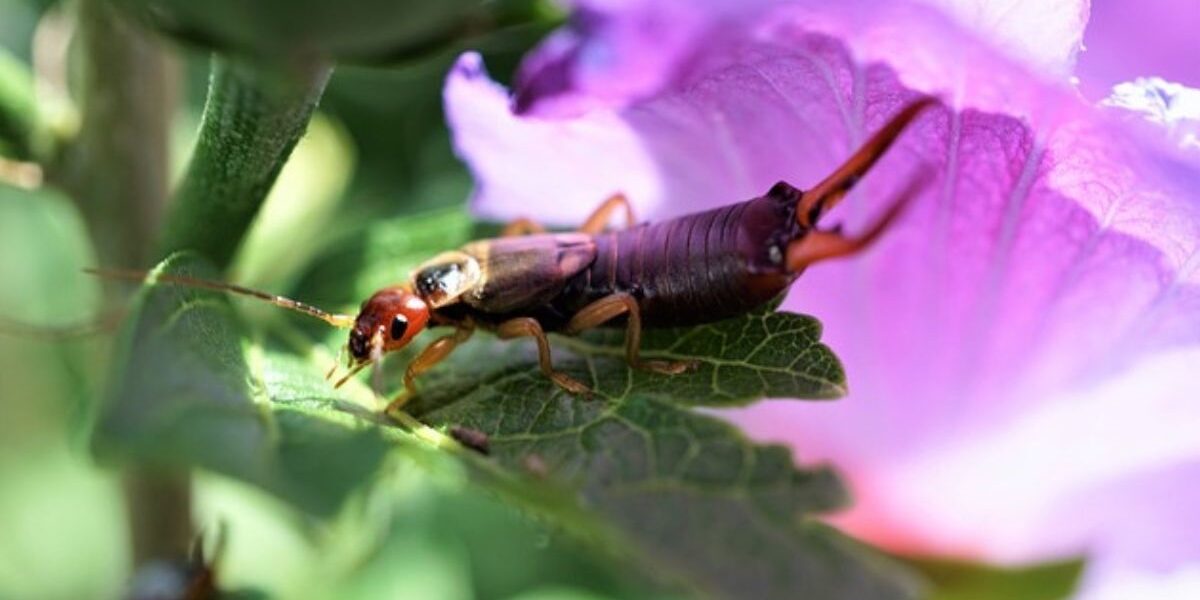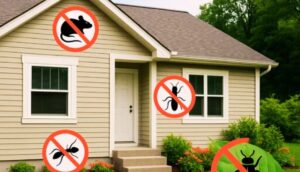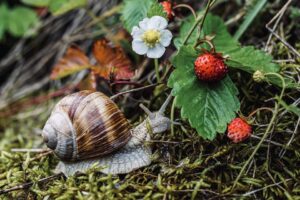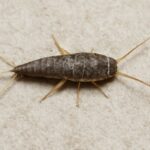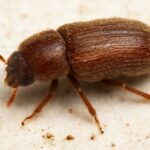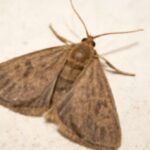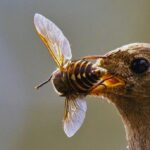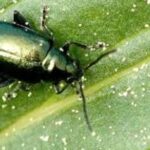Earwig Control in the Home and Garden
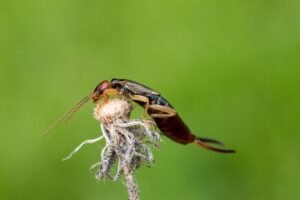
Earwigs are tiny insects found in home gardens and cool areas indoors, There are estimated to be about ” 2000 earwig species worldwide”. These insects are common in garden decomposing wood, under stones, in small moist crevices, underground, in log piles, under leaves, cracks in the foundation, and tree barks. Earwigs are omnivores, their diet consists of other insects for example aphids, mites, sowbugs, cockroaches, spiders, ants, slugs, and snails including the eggs of insects.
Earwigs also consume, some plant species, decaying vegetation such as composting leaves, vegetables, fruits, decaying plant matter located under wet mulches, dog food, bread, etc.. Earwigs are nocturnal insects that hide and rest during the daytime but are active at nighttimes when feeding begins. If their numbers are allowed to grow (infestation) can become a nuisance.
Earwig Identification
Earwigs possess a three-part elongated body that is 1/4 to 1 inch long, they have two antennae, six legs, and pincers (appendages known as cerci). Earwigs range in colors from brown to black.
Signs of Earwigs in the Home Garden
Signs that you have earwigs in your garden.
- Seeing them alive or dead.
- Small jagged chewed holes in fruit.
- Holes in the leaves of seedlings.
- Edges of flowers and leaves that are jagged or shredded.
- Tops of seedlings may be completely removed.
- Flowers and leaves have irregular holes.
- Because earwigs are nocturnal insects, go into your garden at night with a flashlight. As you inspect your garden you should see them.
- Reduce outdoor moisture as much as possible.
- Remove leaves and other debris from your gutter, this will eliminate places for earwigs to hide.
How to Control Earwing in the Home Garden
Following these steps will help to reduce the number of earwigs in your garden bringing complete control.
- The eggs of earwigs hatch in about a week after eggs were laid by the female, the earwig nymphs emerge from their nest around late May to Early June. They become adults in late June to early July and become active during fall. Get into your gardens around this time and monitor or inspect for earwig presence.
- Eliminate outdoor habitat by the removal of fallen leaves and debris.
- Weed removal will reduce earwig-hiding spots.
- Remove fruits from trees when they are ripped.
- Don’t allow fallen fruits and veggies to remain in your garden, the removal of fruits and veggies can help to discourage the presence of earwigs.
- Mulches also harbor earwigs so keep a close eye on the amount of mulch that is applied to garden beds and other areas of your garden. Because mulches retain moisture that will attract earwigs.
- Because earwig inhabits tree bark, remove any bark that is lost.
- Avoiding over-irrigation in your garden will reduce moisture that will discourage earwigs.
- Crop rotation should be done on an annual basis to disrupt earwig feeding and breeding patterns.
- Cultivating the soil to expose overwintering earwigs and their eggs to their predators.
- Remove or cut back vegetation that is growing too close to your house.
- Repair any outdoor pipes or faucets that are leaking to reduce excess moisture.
- Repair damaged door and window screens.
Traps to Capture Earwigs in Your Garden
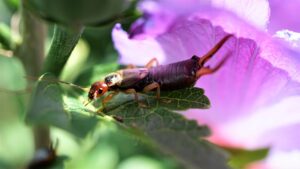
Employing physical traps and barriers can help to control the earwig population.
- Cardboard traps coated with petroleum jelly are an effective way to trap earwigs.
- Wrap a layer of plastic wrap around your tree trunk followed by placing 2-3 wide vaseline going around the plastic wrap. This will create a sticky barrier discouraging earwigs from climbing up the fruit tree to feed on your fruits. This procedure should be done when the fruits start to ripen, keep plastic warp on the tree until the fruits are harvested. In the event of rain, vaseline may need to be reapplied, however, avoid vaseline making direct contact with the tree trunk may cause damage.
- Near the base of the crops you are growing, place damp newspaper or straw, during daytime earwigs will use straw or newspaper as shelter. Now collect and dispose of earwigs.
- Oil traps are effective in the control of earwigs, go around your garden and place small disposable bowls in prone areas, the bowls should be buried where only the top is level with the ground. Pour a little bit of olive oil into the bowls along with sprinkling some saucer source that will attract earwigs. Once earwigs climb into the bowl they will get trapped in the oil.
Biological Control to Manage Earwigs
Biological control is a safe practice to Reduce the earwig population.
- Releasing or encouraging beneficial insects into your garden will reduce the earwig population, the way this works is that the beneficial insects that are known as the good guys feed on insect pests. Some examples of beneficial insects are assassin bugs, predatory wasps, praying mantis, ground beetles, etc… However, be careful of the amount of praying mantis or ground beetles that are released in your garden because beneficial insects have no discretion and will feed on each other.
- Encouraging lizards, birds, toads, and frogs into your garden will use earwigs as a food source.
Insecticides to Control Earwig in Your Garden
Insecticides can be used to control earwigs, there are broad spectrums that can be used not only to control earwigs but a host of garden insect pests.
Before treating Eawigs in your garden with insecticides make sure you’re wearing PPE that will provide production, long clothing, eye goggles for eye protection, chemical-resistant gloves, and a safety mask. Before the application of insecticides read the label for the control of earwigs also read and follow the manufacturer’s directions on the label for safe use and to get good results and keep children and pets out of treated areas until pesticides are completely dried.
- Insecticidal soap is effective in controlling earwigs.
- Food Grade Diatomaceous earth can be applied both out and indoors, as insects including earwigs crawl over the powder it damages their skin causing dehydration and death. Food Grade Diatomaceous earth is safe to use indoors.
Signs of Earwig in the Home
If earwigs are present indoors look for these signs.
- You may see them alive or dead.
- Smelling foul odor that earwig emits, the reason for this is when an earwig feels threatened or detects danger will emit this odor to scare away predators. When crushed earwigs also give off this foul odor.
- Indoor plants with leaves bitten.
- Vegetables and fruits in your kitchen with holes and black spots.
How to Control Earwig in the Home
For the Control of earwigs indoors.
- Before bringing cut flowers or potted plants into your home inspect for earwigs and other insect pests that might be hitchhiking.
- Inspect fruits and vegetables before bringing them indoors.
- Downspouts should direct water away from your home’s foundation to reduce moisture which will keep earwigs at abay or seeking shelter in your home.
- When scouting for earwigs indoors look for them in areas such as laundry room, garage, bathroom, basements, and other areas of your home that can become humid.
- Cluttered areas should also be inspected.
- Check around your doors and windows for cracks and repair them with caulk or other sealant.
- Make sure that door sweeps are in place or in good repair
- Cracks and crevices in your home’s foundation should be sealed with caulk or sealant.
- Small openings around water and utility pipes that enter your home should be sealed with caulk.
- Repair any indoor pipes or faucets that are leaking to reduce excess moisture.
Treating Earwigs Indoors with Insecticides
Before treating Eawigs indoors with insecticides make sure you’re wearing PPE that will provide protection, long clothing, eye goggles for eye protection, chemical-resistant gloves, and a safety mask. Before the application of insecticides labeled for the control of earwigs always read and follow the manufacturer’s directions on the label for safe use and good results and keep children and pets out of treated areas until pesticides are completely dried.
Some insecticides that can be used are Ficam, Reclaim IT, or D-Fence insect dust.
- Treat around your doors, window frames, where plumbing pipes enter your home, and around your garage
- Apply Reclaim IT along the perimeter of your house foundation by spraying 2-3 feet up your home’s foundation and 2-3 feet out until the entire perimeter of your house foundation is treated, under normal conditions Reclaim It will leave a repellent residual for up to 90 days. Ficam is a granule that is moisture and weather-resistant and can be applied as a spot treatment to treat areas where earwigs were spotted for example sprinkle Ficam around wood piles including firewood, garden beds, leaf piles, and mulch.
- D-Fence Dust is a powder that is applied to cracks, crevices, and wall voids around switch plates and electrical outlets, behind baseboards, and under sinks where plumbing pipes go through the wall, around and under large appliances. To accomplish this you will need a handheld duster, fill the handheld duster halfway with dust return the duster cover, hold the duster with the cavity to the booty shake, and squeeze the dust to release the dust. As you apply 1-2 puffs of dust is sufficient. When applying to electrical outlets cut off the power first, also don’t apply dust directly into the outlet but behind electrical outlets and switch plates.
- Food Grade Diatomaceous earth can be applied both out and indoors, as insects including earwigs crawl over the powder willl damage their skin causing dehydration and death. Food Grade Diatomaceous earth is safe to use indoors.
10 Frequently Asked Questions (FAQs)
1. What exactly are earwigs, and why are they in my garden?
Earwigs are small, brownish insects with pincers on their back end. They’re drawn to moisture, mulch, and decaying plant matter—basically, the cozy, damp spots in your garden. While they help break down organic material, too many can damage your plants.
2. Are earwigs harmful to my plants?
Yes, they can be. A few earwigs won’t hurt, but large numbers can chew holes in leaves, flowers, and soft fruit. Seedlings and tender young plants are especially at risk from earwigs
3. How can I tell if earwigs are the problem in my garden?
Look for jagged holes in leaves or petals, particularly on damp mornings or after watering. You might also find them hiding under pots, mulch, or garden debris during the day—they’re nocturnal, so they do most of their munching at night.
4. What are some ways to get rid of earwigs naturally?
Try rolled-up damp newspaper or old cardboard tubes as traps—earwigs crawl in at night and you can shake them out in the morning. Diatomaceous earth is another great natural option; sprinkle it around plants to dry out and kill earwigs without chemicals.
5. Do earwigs bite or pinch people?
Not really! Those pincers look scary but are mostly used for defense and mating rituals. Earwigs rarely pinch humans, and if they do, it’s harmless—just a little uncomfortable, not dangerous.
6. Should I be using insecticides to kill earwigs in my garden?
Only as a last resort. Most insecticides can harm beneficial bugs, too—like bees and ladybugs. Try eco-friendly methods first. If you must use chemicals, look for a targeted pesticide and apply it carefully, following all label instructions.
7. Can I prevent earwigs from coming back?
Absolutely! Reduce moisture, clear out leaf piles, and avoid over-mulching. You can also seal cracks in fences or raised beds and water early in the day so your garden dries before nightfall, when earwigs come out.
8. Are earwigs ever beneficial in the garden?
Yes, in moderation. Earwigs help break down dead plant material and even eat garden pests for example aphids. The key is balance—a few are fine, but a swarm is a problem.
9. What time of year are earwigs most active?
Earwigs are busiest in warm, moist seasons—usually late spring through summer. They love hiding during the day and become most active at night when it’s cool and damp.
10. Can chickens or birds help control earwigs?
Definitely! Chickens, ducks, and even wild birds like robins love snacking on earwigs. If you’re into natural pest control and already have backyard birds, you’re in luck—they’ll gladly do the job for you!
Conclusion
I know that we have said a lot about earwigs and how to control them, these steps once applied will bring earwigs under control or deter them from your home. While your efforts may not remove earwigs completely from your garden will reduce their population and they will no longer be a threat to the health of your garden plants nor become a nuisance indoors. Stop earwigs in their tracks with this helpful guide and join the many who are having success with the implementation of these methods.

